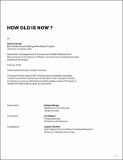How Old Is Now?
Author(s)
Giorgis, Adriana
DownloadThesis PDF (49.20Mb)
Advisor
Miljački, Ana
Terms of use
Metadata
Show full item recordAbstract
L’Aquila is a city without new buildings. Founded in the early 13th century on a fault line, the city has been destroyed by earthquakes every three hundred years. Its buildings are repaired on the same cycle. In l’Aquila, acts of construction and maintenance are one and the same. Through centuries, buildings in l’Aquila have been reinforced with punctual, visible, acts of support. Tension ties, corner stones, and thickened walls are the language of architecture, producing both aesthetic and spatial implications. In this city, to maintain is to remake, to build is to preserve, to care is to create. When life and life-expectancy of structures is literally infinite, there can be no differentiation between repair and construction.
This project dwells on l’Aquila’s architectural value systems. The absence of ‘new’ buildings in the city is made possible by a culture of collective acts of repair. In the long-now, kindnesses reinforce, prop-up, and adjust materials that have bore witness to historical events and familial genealogies. What might it mean for the discipline to center maintenance the way it has been centered in l’Aquila? What are the ways that the architect-maintainer conceives of originality? Of design? How, too, might they care for the ongoing present and future of l’Aquila?
Date issued
2024-02Department
Massachusetts Institute of Technology. Department of ArchitecturePublisher
Massachusetts Institute of Technology